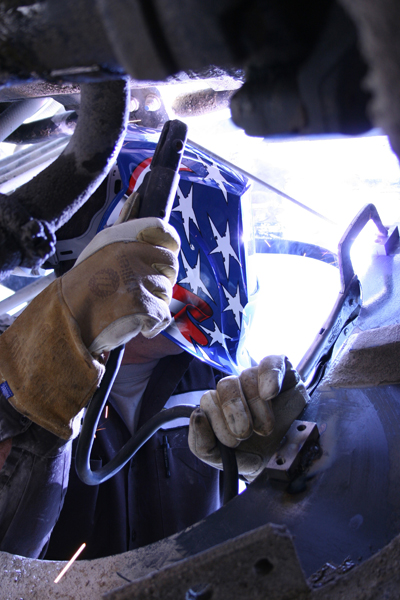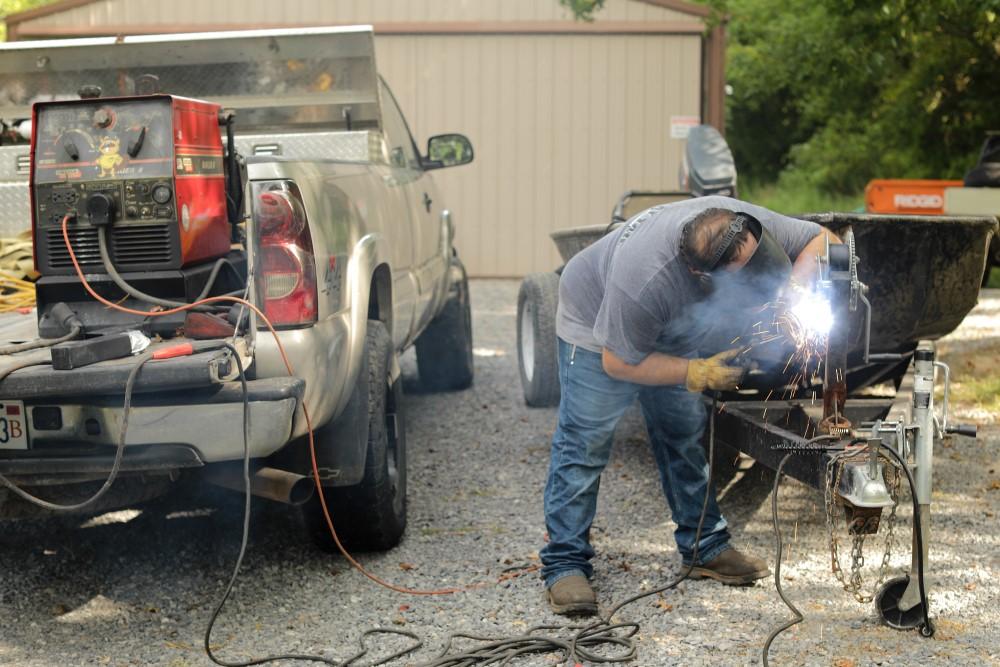Everything about Welding: Key Insights Into Techniques and Best Practices for Success
Welding incorporates a selection of methods, each matched for details products and applications. Understanding these methods, such as GMAW, SMAW, and TIG, is important for accomplishing suitable outcomes. In addition, the appropriate devices and safety and security techniques can not be ignored. As prep work and fixing play essential roles in the welding procedure, mastering these aspects can considerably boost the top quality of the last product. What are the crucial elements that guarantee a successful weld?
Recognizing Different Welding Strategies
Welding methods include a selection of approaches, each fit to specific applications and products. Among the most usual methods are Gas Steel Arc Welding (GMAW), Shielded Steel Arc Welding (SMAW), and Tungsten Inert Gas Welding (TIG) GMAW, additionally referred to as MIG welding, is preferred for its rate and adaptability, making it excellent for thin products. SMAW, or stick welding, is favored for its simpleness and effectiveness in exterior environments, specifically with thicker metals. TIG welding uses precision and control, making it ideal for detailed job and non-ferrous steels (Montana Mobile Welding and Repair Belgrade). Each strategy has its distinct benefits and considerations, allowing welders to pick the very best technique based upon the project's requirements, product type, and desired results. Recognizing these techniques is essential for successful welding
Necessary Welding Tools and Devices
While numerous welding techniques call for details skills, the right equipment and devices are equally crucial for achieving quality results. Crucial welding equipment consists of welding makers, which differ relying on the method-- such as MIG, TIG, or stick welding. Protective gear, including gloves, safety helmets, and aprons, warranties safety and security and convenience throughout the process. Furthermore, clamps and fixtures assist protect materials in place, guaranteeing accuracy in welds. Consumables like welding poles, cord, and protecting gas are also important elements that influence the quality of the weld. Tools such as cutters and mills promote surface preparation and post-weld completing, adding to a specialist outcome. Buying top quality equipment inevitably improves the performance and effectiveness of welding tasks.
Security Practices in Welding
Appropriate safety methods are essential in the welding sector to secure workers from potential dangers. Welders should wear ideal personal protective tools (PPE), consisting of headgears with proper shading, handwear covers, and flame-resistant clothing. Sufficient air flow is vital to reduce exposure to harmful fumes and gases generated during the welding process. In addition, workers should be learnt the correct handling of welding equipment to stop accidents. Fire security measures, such as keeping flammable materials far from the welding location and having fire extinguishers easily offered, are necessary. Regular evaluations of tools and offices can aid identify potential dangers before they result in mishaps. By sticking to these safety methods, welders can develop a more secure working setting and lessen threats connected with their trade.
Readying Products for Welding
Preparing materials for welding is a crucial action that substantially affects the quality and honesty of the last item (Montana Mobile Welding and Repair Fabrication). Appropriate prep work includes cleansing the surfaces to get rid of impurities such as rust, oil, and dust, which can compromise the weld. Strategies such as grinding, fining sand, or utilizing solvents are frequently employed to accomplish a tidy surface area. Additionally, ensuring that the products fit with each other snugly is necessary; spaces can cause weak welds. It's likewise important to think about the placement and positioning of the elements, as this will affect the ease of welding and the last result. Lastly, picking the suitable filler material and ensuring compatibility with the base steels is necessary for accomplishing solid, long lasting welds
Tips for Achieving High-Quality Welds
Accomplishing top notch welds needs focus to information and adherence to best techniques throughout the welding procedure. Proper joint prep work is vital, guaranteeing surface areas are tidy and free from pollutants. Choosing the proper filler material and welding method based upon the base steels is crucial for suitable bonding. Keeping consistent travel speed and angle while welding can promote and avoid flaws harmony. In addition, regulating warmth input is necessary; too much warm can result in warping and deteriorated joints. If essential, regularly inspecting the welds during the process allows for instant adjustments. Using suitable post-weld therapies, such as cleaning and tension relief, can improve the resilience and integrity of the weld, inevitably making sure a successful end result.
Repairing Typical Welding Issues
Welding typically presents obstacles that can impact the high quality and stability of the end product. Typical issues such as porosity, irregular weld grains, e7018 and overheating can emerge, each needing specific repairing techniques. Recognizing these problems is necessary for welders to enhance their abilities and attain optimal results.
Porosity Troubles Discussed
Porosity can frequently be neglected, it continues to be a vital concern in welding that can jeopardize the integrity of a completed item. Porosity refers to the presence of tiny gas pockets within the weld grain, which can weaken the joint and lead to early failure. This trouble normally occurs from pollutants, dampness, or improper protecting gas coverage throughout the welding procedure. To reduce porosity, welders must confirm that the base products are dry and tidy, utilize suitable protecting gases, and keep regular welding parameters. Regularly inspecting the tools and setting can likewise assist determine possible issues before they materialize in the weld. Resolving porosity properly is vital for attaining solid, sturdy welds that fulfill top quality criteria.

Irregular Weld Beads
Irregular weld grains can substantially affect the top quality and strength of a completed product. Numerous factors add to this issue, including incorrect travel speed, inaccurate amperage setups, and irregular electrode angles. When the welder moves also rapidly, a grain might appear narrow and lack infiltration, while relocating as well slowly can create extreme accumulation. In addition, using the wrong amperage can lead to either undercutting or too much spatter, both of which compromise weld honesty. The welder's technique, such as irregular torch motion, can additionally cause irregular grain look. To minimize these troubles, welders need to concentrate on keeping constant, regulated movements and ensuring correct devices setups to attain uniformity in their welds. Uniformity is essential to accomplishing reputable and solid welds.
Overheating and Warping Issues
Excessive warm during the go to the website welding procedure can result in substantial getting too hot and warping problems, impacting the structural honesty of the work surface. These issues often show up as distortion, which can endanger positioning and fit-up, making additional assembly testing. Variables contributing to overheating include the option of welding specifications, such as voltage and travel speed, along with the kind of product being welded. To minimize these problems, welders ought to maintain constant travel speed and appropriate warmth input while monitoring the workpiece temperature. Additionally, pre-heating or post-weld warm therapy can assist ease stress and anxieties brought on by quick cooling - Fabrication. Routine inspection and adherence to finest methods are necessary in preventing getting too hot and making sure the long life and integrity of welded frameworks
Regularly Asked Inquiries
What Are the Profession Opportunities in the Welding Sector?
The welding industry provides varied career possibilities, including settings as welders, instructors, inspectors, and designers. Specialists can function in production, construction, aerospace, and vehicle sectors, gaining from strong demand and competitive wages in different roles.
How Can I Boost My Welding Rate Without Compromising High Quality?
To boost welding speed without sacrificing quality, one ought to practice reliable strategies, preserve devices, optimize settings, and enhance hand-eye sychronisation. Routine training and looking for responses can likewise greatly add to attaining faster, high-grade welds.
What Accreditations Are Readily Available for Welders?
Many accreditations exist for welders, including those from the American Welding Culture (AWS), the National Facility for Building And Construction Education And Learning and Study (NCCER), and numerous industry-specific companies. These credentials enhance employability and show skill proficiency.
How Does Welding Influence the Qualities of Metals?
Welding affects the properties of steels by changing their microstructure, which can cause modifications in ductility, solidity, and strength. Heat input and air conditioning prices during the procedure considerably affect these material attributes.
Can I Weld Dissimilar Metals Together?

Comments on “What causes cracking in welds and how Montana Mobile Welding and Repair avoids them”